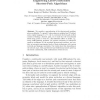Free Online Productivity Tools
i2Speak
i2Symbol
i2OCR
iTex2Img
iWeb2Print
iWeb2Shot
i2Type
iPdf2Split
iPdf2Merge
i2Bopomofo
i2Arabic
i2Style
i2Image
i2PDF
iLatex2Rtf
Sci2ools
AAIM
2008
Springer
2008
Springer
Engineering Label-Constrained Shortest-Path Algorithms
We consider a generalization of the shortest-path problem: given an alphabet , a graph G whose edges are weighted and -labeled, and a regular language L , the L-constrained shortest-path problem consists of finding a shortest path p in G such that the concatenated labels along p form a word of L. This definition allows to model, e. g., many traffic-planning problems. We present extensions of well-known speed-up techniques for the standard shortest-path problem, and conduct an extensive experimental study of their performance with various networks and language constraints. Our results show that depending on the network type, both goal-directed and bidirectional search speed up the search considerably, while combinations of these do not.
AAIM 2008 | Algorithms | L-constrained Shortest-path Problem | Shortest-path Problem | Standard Shortest-path Problem |
| Added | 24 Oct 2010 |
| Updated | 24 Oct 2010 |
| Type | Conference |
| Year | 2008 |
| Where | AAIM |
| Authors | Christopher L. Barrett, Keith R. Bisset, Martin Holzer, Goran Konjevod, Madhav V. Marathe, Dorothea Wagner |
Comments (0)

